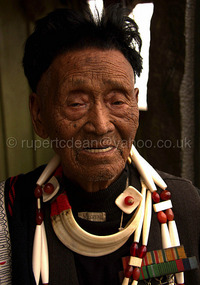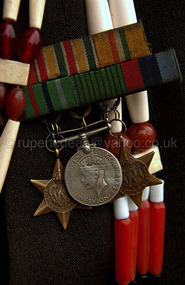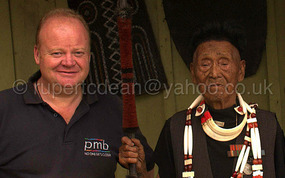Mr Sosangtemba Longkumer Ao
I was fortunate to get introduction to Sosangtemba from my friend Akok on my last visit to Mokokchung
. It is not often you get the chance to meet and talk with a WW2 war veteran and myself, Akok and Langa Chuba went to meet him in his bungalow in the ancient village of Longsa.
Akok had told me that Sosangtemba was 97 years old, but I was not quite prepared for how fit and active he was during our visit. He was certainly pleased to see us and shock my hands in a long grip for several minutes whilst excitedly talking to Akok in his native Ao language.
Sosangtemba was a gracious host and welcomed us into his small and quite spartan bungalow. Outside at the entrance were two impressive war shields next to a large stone that had been erected in his honour. He was now one of the few remaining veterans of the war in India and Burma and was excited to tell us his story, which he narrated under the gaze of all his photos from the last century.
We were not to sure how his story would develop. Akok had spoken with Sosantemba’s relatives before approaching the old man. Neither of his sons knew what he done in the war and where he had been sent, but they were aware of his medals and of course the respect with which he is accorded in Longsa.
Initially Sosangtemba was so pleased to be talking to us that all his memories seemed to flood out all at once and this greatly confused both Akok and Langa who were kindly doing the translation
. However, as soon as things had settled down the his story started to emerge.
Sosangtemba first encountered the British in his early 20s. This was when the British sent word to the administered districts of modern day Nagaland that they wished to construct a road from Dimapur to Imphal and then crossing into Burma. For this task the British ordered all the tribal elders to produce men to act as labourers. From what we could understand, this order meant that Longsa had to contribute ten men. Sosantemba was one of the men selected.
In total, Sosantemba recalled that there were men from the Konyak, Chang, Ao, Angami, Chakesang, Sumi, Sangtam and Lotha tribes. These recruits were then assembled in Kohima where it appears they got to know the British, many for the first time in their lives. It also appears this was the first time that many of these men had met other Naga tribals. I was interested to understand how these different tribal men communicated (as there is no traditional Naga common language amongst the tribes) but Sosangtemba was adamant that this was no problem as they all spoke to each other in a broken form of Assamese which later became known as Nagamese.
Sosantemba did recall meeting a “Sir Adam,” whom he recalled was the District Commissioner of Kohima
. He mentioned rather fondly that all the Nagas would play football against the British. He had particularly good memories of this “Sir Adam” whom he added only treated “us Nagas with respect and kindness.” However he then added, “we of course had to obey their rules and we had no choice but to do what they told us to do.” This control appeared absolute as “Sir Adam” also appointed all the village elders.
It certainly appears that all the Nagas in Kohima had a great time while they were awaiting their orders to leave for their posting. Because he was one of the last to arrive in Kohima he was posted to Manipur (the neighbouring state and gateway to Burma) and before leaving he was given a medical examination plus some injections. This procedure appears to have made quite a large impression on Sosantemba as he referred to it quite regularly over the next few hours.
Once en route to Imphal by foot they rested first at Mao close to the modern state border that separates Manipur from Nagaland. From here it appears that they took a vehicle to the cosmopolitan town of Ballen before moving onto a Kuki tribal area. Here they eventually arrived at a town on the Burmese border, which he referred to as Laksu-Pani and it was here that they built a bridge
. When they had completed the bridge they crossed the border and entered into Burma and were then ordered to prepare a supplies and weapons base. which “the British told us must be held against any Japanese attack.”
It was from this position that he witnessed the invasion of Burma saying he could hear the war approaching and see the fighting and fires at night. They also heard stories from the refugees of the battles around Rangoon. He went on to recall how he witnessed the British retreat from the Japanese advance and the resulting horrific scenes of one of the biggest retreats of British and the Allied Forces in the second wold war. Everything and everyone was retreating along this road they were constructing.
As the Japanese advance became relentless and it was obvious that the British were defeated, the combined Naga force were also told to retreat back into India and destroy the bridge they had built at Laksu-Pani. With the situation becoming increasing confused and chaotic they all waited for eight days at the remnants of the bridge before retreating back to Imphal.
On reaching Imphal the Nagas encountered for the first time the consequences of air attacks and found the city quite devastated with bodies and the smell of death everywhere. It appears that it was here at Imphal that the decision was taken to return all the way back to Kohima. En route they spotted at least twenty five Japanese planes.
On entering Kohima they found a completely different situation to one they had left. The Monsoon had arrived and consequently no food or supplies had reached the town in days. Immediately we were sent out to open the roads and clear away the debris from the Dimapur highway. After that the British put us in a camp just below the Mission Compound and it was here that we embarked on weeks of training. This included teaching us what to do in the event of an air raid. During this time our rations were quite poor, “actually we thought the British were quite stingy throughout the war. The rice they gave us was quite poor quality and often old. So it was not until we encountered the Americans that the food improved.”
It was around the end of the Monsoon in 1943, September (Sosantemba thought) that he was relieved of his duties and returned to his village of Longsa with the other ‘volunteers’. These men were swiftly replaced by another ten volunteers from Longsa who left for Kohima. When we left the front the British told us, “not to give the Japanese any of our weapons and we were also told to resist them in our villages.”
“It was during the following year that we could hear the Battle of Kohima from here in Longsa.” Since he had returned to Longsa from Kohima, Sosantemba said he had encountered no Japanese on their advance into India and the noise of the battle was the first indication that they had advanced into Naga territory. He remained in Longsa for the remaining duration of the war.
He then spoke about Indian Independence, saying that when it was announced the whole village was talking about it. The village elders were asked to assemble in Kohima, (maybe by Charles Pewsey) on the pretext that the “British wanted to say farewell.” During this meeting it was asked of our elders whether the “Nagas” wanted to be part of the ‘new’ India. Sosantemba stated that he knew that “our village elder, played an important role in telling the British that the Nagas wanted independence. However he added that after this meeting in Kohima, it became apparent that the British had not promised anything or even said that they would speak with the new Indian Government.
Back in Longsa, it quickly became apparent to everyone that the British were not going to do anything on behalf of the Nagas desire for independence. Many “of us felt suddenly betrayed by the British. With the Indian talks achieving little many Nagas simple joined the freedom fighters, especially when the Indians started to abuse our people. Unfortunately over time, the Nagas also started to fight amongst themselves.”
By this stage Sosantemba was getting quite tired, so we decided that we should leave, however he was keen to have his photograph taken outside his cottage beside his monolith. For this he wore his waistcoat and pinned his three medals to it including his Burma star and one with George V. Then he drooped his beautiful AO shawl across one shoulder and grabbed a fantastic Naga spear and stood next to the stone. We left after another round of handshakes. I told him that I looked forward to meeting him on my next visit and he said that “you had better come back quickly.”
On parting I asked him for his secret to his long life and he said, “ do hard work and don’t just sit around and eat!”
Meeting Mr Sosangtemba Longkumer Ao
Thursday, March 26, 2015
 Longsa, Nagaland, India
Longsa, Nagaland, India
Other Entries
-
98Birds, Fog, Bad Internet, Old Friends
Jan 1471 days prior Jodhpur, Indiaphoto_camera7videocam 0comment 0
Jodhpur, Indiaphoto_camera7videocam 0comment 0 -
99Tigers Tigers Tigers Tigers and oh Tigers
Jan 1768 days prior Sawai Madhopur, Indiaphoto_camera6videocam 0comment 0
Sawai Madhopur, Indiaphoto_camera6videocam 0comment 0 -
100Trains, Rodents, Rip offs, Delhi and Gentle
Jan 2560 days prior Delhi, Indiaphoto_camera3videocam 0comment 0
Delhi, Indiaphoto_camera3videocam 0comment 0 -
101Sand, Masks, Forest Man, Monks & Bamboo
Feb 0252 days prior Majuli, Indiaphoto_camera8videocam 0comment 0
Majuli, Indiaphoto_camera8videocam 0comment 0 -
102Julius, Gibbons, Park Fees, Tea & Gymkhana
Feb 0549 days prior Jorhat, Indiaphoto_camera5videocam 0comment 0
Jorhat, Indiaphoto_camera5videocam 0comment 0 -
103Houseboats, Dolphins, Rain and Animal Planet
Feb 1044 days prior Tinsukia, Indiaphoto_camera5videocam 0comment 0
Tinsukia, Indiaphoto_camera5videocam 0comment 0 -
104Tezu family home, TV Mike, Huts, Cows, River Wash
Feb 1440 days prior Tezu, Indiaphoto_camera5videocam 0comment 0
Tezu, Indiaphoto_camera5videocam 0comment 0 -
105Sumos, Boulders, Oranges, Idu Mishmi
Feb 1737 days prior Roing, Indiaphoto_camera5videocam 0comment 0
Roing, Indiaphoto_camera5videocam 0comment 0 -
106Motorbikes, Idu Mishmi, Hats, Illness, Scenary
Feb 1935 days prior Anini, Indiaphoto_camera9videocam 0comment 0
Anini, Indiaphoto_camera9videocam 0comment 0 -
107Nyokum Yullo, Nishi people, ferries, chain dance
Feb 2232 days prior Itanagar, Indiaphoto_camera5videocam 0comment 0
Itanagar, Indiaphoto_camera5videocam 0comment 0 -
108Paddies, Plugs, Tattoos, Weddings, Bamboo, Spirits
Feb 2430 days prior Ziro, Indiaphoto_camera5videocam 0comment 0
Ziro, Indiaphoto_camera5videocam 0comment 0 -
109Post Office, Hari's Help, Tourist Apartheid
Mar 0125 days prior Guwahati, Indiaphoto_camera3videocam 0comment 0
Guwahati, Indiaphoto_camera3videocam 0comment 0 -
110Hornbills, Eco Lodge, Birds, Elephants & Nameri NP
Mar 0323 days prior Tezpur, Indiaphoto_camera5videocam 0comment 0
Tezpur, Indiaphoto_camera5videocam 0comment 0 -
111Plans Changing, Bus tyres, early closing museums
Mar 0818 days prior Kohima, Indiaphoto_camera2videocam 0comment 0
Kohima, Indiaphoto_camera2videocam 0comment 0 -
112Wildlife, History, Bad Roads, Elephants & Dust
Mar 1313 days prior Wokha, Indiaphoto_camera5videocam 0comment 0
Wokha, Indiaphoto_camera5videocam 0comment 0 -
113Wedding, More Dust, Shawls, Tensions and Sumi Food
Mar 206 days prior Zunheboto, Indiaphoto_camera3videocam 0comment 0
Zunheboto, Indiaphoto_camera3videocam 0comment 0 -
114Stones, Inventions, Old Friends and Shop 65
Mar 242 days prior Mokokchung, Indiaphoto_camera5videocam 0comment 0
Mokokchung, Indiaphoto_camera5videocam 0comment 0 -
115Meeting Mr Sosangtemba Longkumer Ao
Mar 26 Longsa, Indiaphoto_camera4videocam 0comment 0
Longsa, Indiaphoto_camera4videocam 0comment 0 -
116Expensive Transport, Rain, Football, Cockroaches
Mar 282 days later Longleng Nagaland, Indiaphoto_camera3videocam 0comment 0
Longleng Nagaland, Indiaphoto_camera3videocam 0comment 0 -
117Pork, Pigs, Moon Singing, Monsoon, Footy
Apr 016 days later Wakching, Indiaphoto_camera10videocam 0comment 0
Wakching, Indiaphoto_camera10videocam 0comment 0 -
118Aoling Festival, Rain, Easter, Rain, Rain
Apr 0611 days later Wakching, Indiaphoto_camera10videocam 0comment 0
Wakching, Indiaphoto_camera10videocam 0comment 0 -
119The Not Super Travel Co, Tea, Temples & Bye Byes
Apr 1015 days later Kamakhya, Indiaphoto_camera5videocam 0comment 0
Kamakhya, Indiaphoto_camera5videocam 0comment 0 -
12035c, Haveli, Pink City, Amber Fort, Tigers, Tigers
Apr 1520 days later Sawai Madhopur, Indiaphoto_camera5videocam 0comment 0
Sawai Madhopur, Indiaphoto_camera5videocam 0comment 0 -
121Taj, Baby Taj, carpets, arguments, fever plus 43c
Apr 1823 days later Agra, Indiaphoto_camera5videocam 0comment 0
Agra, Indiaphoto_camera5videocam 0comment 0 -
122Mud, Mangroves, Kingfishers, Boats, Storms, Otters
Apr 2227 days later Sundarbans National Park, Indiaphoto_camera10videocam 0comment 0
Sundarbans National Park, Indiaphoto_camera10videocam 0comment 0 -
123Last Days in Kolkata, Obsolete Passports, Thailand
May 0136 days later Koh Chang, Thailandphoto_camera10videocam 0comment 0
Koh Chang, Thailandphoto_camera10videocam 0comment 0 -
124Getting home, reflections and thoughts
May 1348 days later Bristol, United Kingdomphoto_camera3videocam 0comment 3
Bristol, United Kingdomphoto_camera3videocam 0comment 3

 Longsa, Nagaland, India
Longsa, Nagaland, India






2025-05-22